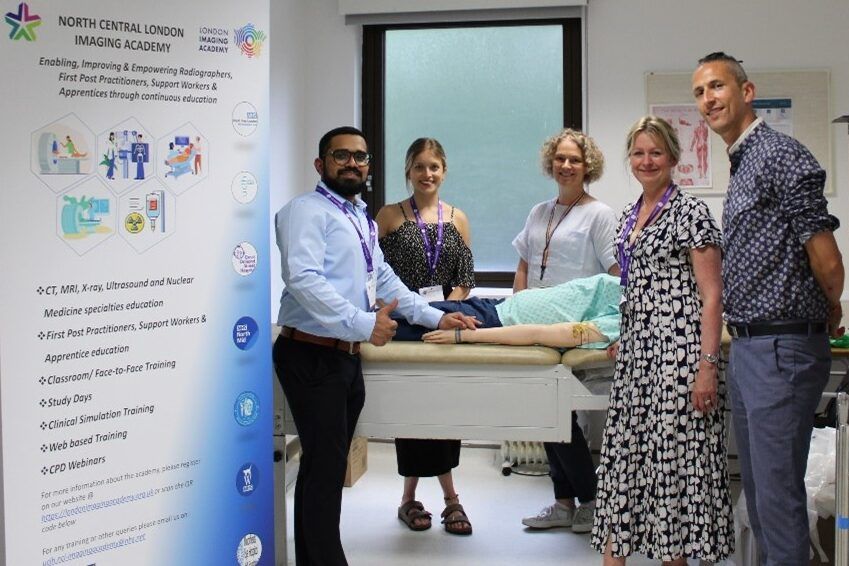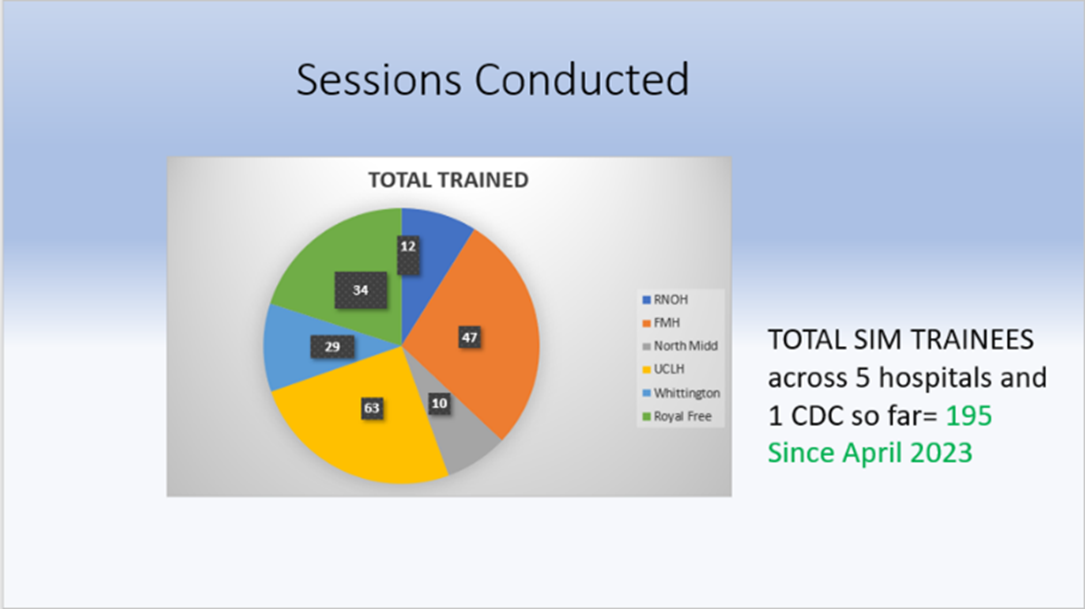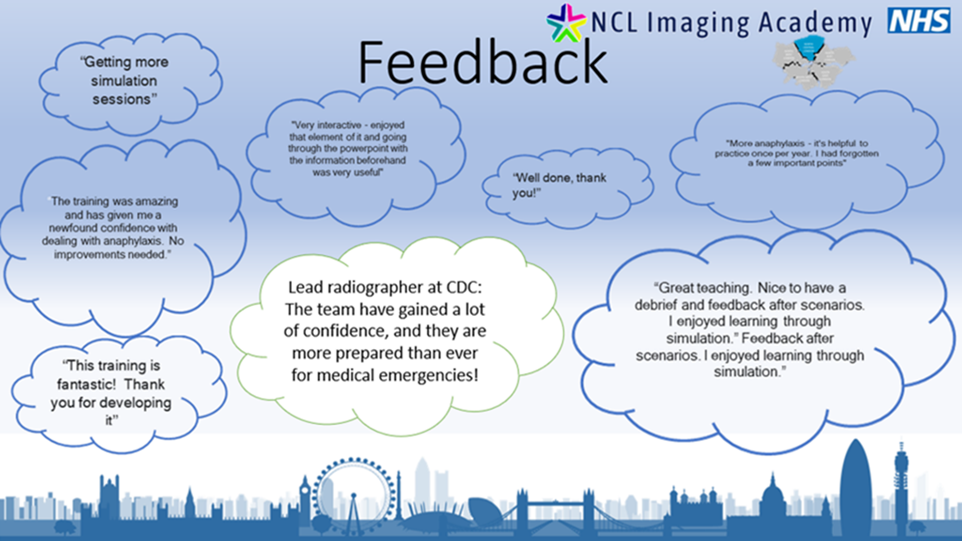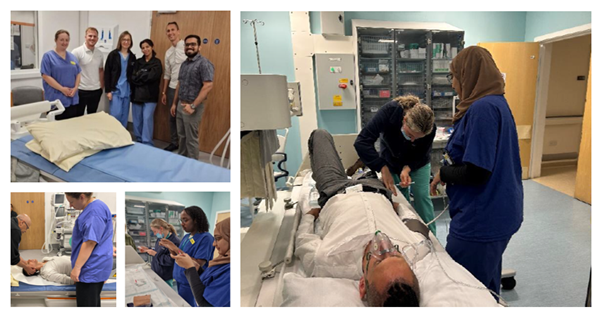

Introduction
The North Central London Imaging Academy (NCLIA) is taking proactive steps to enhance patient safety and equip its staff with the necessary skills to handle medical emergencies. The practice education team at NCLIA has introduced immersive group clinical simulation training sessions for radiographic and support worker staff across its network. In this article, we delve into the details of our training package, including programme aims, why it was needed, how we brought it together and the benefits achieved.
Programme aims
1.Develop a network wide clinical simulation programme to improve safety, staff confidence and support both acute & community activity.
2.Increase workforce confidence and competence through educating radiographers and imaging support workers to recognise and safely look after their patients in cases of deterioration and adverse reactions including anaphylaxis.
3.Increase patient safety in the Imaging departments across the network fostering an environment where staff are equipped to respond adeptly with deteriorating and unwell patients.
4.Improve breadth of patient cohort able to attend the community diagnostic centres for elective scanning removing the dependency on medical staff and support backlog reduction.
The Early Days: A Pilot Simulation Program
This training package was actually born out of a pilot simulation programme we ran back in 2016, at that time we had a larger faculty which included simulation specialists, radiologists, radiographers and pert nurses, we piloted different delivery methods and ran both in situ training and off site training at our education centre, we utilised a hi-tech mannequin and managed to train most of the imaging department staff at UCLH over a period of 1 year. We gained really positive feedback from all who took part and this really helped lay a strong foundation for our current faculty and really proved to us the value of simulation based education as a powerful training mechanism.
The NCL Imaging Academy
Fast forwards to 2022 and the creation of the ‘NCL Imaging academy’ which is a part of the ‘London Imaging Academy’. Our multimodality practice education team was set up, dedicated to a highly collaborative Imaging Network of 7 acute hospitals and 2 community diagnostic centres. Our mandate is enhancing access to training and development for all Imaging staff, sharing learning, expertise and best practice through both face to face and virtual training. Whilst discussing potential ideas for innovative training courses as a team we relished the opportunity to reinstate and develop the simulation training programme we had run in the past but this time we aimed to facilitate it for the whole North Central London network. So, let’s have a look at why the project was needed.
The Need for Clinical Simulation
As mentioned, parts of our network include community diagnostic centres (CDCs) one of which is based at Finchley Memorial Hospital. CDCs are aimed at building capacity for more diagnostic testing in England and relieving pressure on acute hospitals. They are multi-diagnostic facilities, separate from acute hospitals and placed in local communities. As a result, imaging staff are required to work without onsite doctors, this necessitates that routine ‘contrast’ scans can only be carried out if Imaging staff are proficient in handling adverse reactions as part of a standard operating procedure.
Without the ability to provide adequate capacity for patients requiring contrast enhanced imaging, the CDC in NCL was unable to have the required impact on network waiting times. This was affecting their ability to deliver their activity and income plan.
Training needs analysis across NCLs Imaging Network confirmed significant gaps in knowledge and confidence amongst Imaging staff in recognising and managing medical emergencies and adverse reactions in both acute and community settings.
• 100% of staff stated they were uncomfortable in the A-E assessment.
• Nearly half of all were not confident in performing an airway manoeuvre.
• Half were not comfortable administering IM adrenalin for anaphylaxis treatment.
• Many had never received any type of training in anaphylaxis.
Guidance provided by NHS England and the Royal College of Radiologists (RCR) in July 2021 emphasises the importance of trained staff being able to recognise and treat severe contrast reactions including anaphylaxis.
In the event of anaphylaxis, the Society of Radiographers states that “any person who can recognise an anaphylactic reaction is permitted to administer intra-muscular (IM) adrenaline to save a life, whether they are a healthcare professional or not. Radiographers, associated professionals, and clinical support workers can administer adrenaline when trained appropriately.”
These staff should:
Be trained and confident to recognise and manage a reaction promptly and safely.
Furthermore, compliance with the Health and Care Professions Council (HCPC) standards of proficiency clearly state that all registered radiographers should be able to establish and maintain a safe practice environment including using basic life support techniques and be able to deal with clinical emergencies.
How did we implement a comprehensive simulation-based training program?
In response to these standards, guidance and needs, a multidisciplinary faculty was established at the beginning of 2023, comprising 3 practice educators and 3 radiology registrars.
The practice educators have all completed a number of simulation training courses and have recently completed a post graduate certificate in simulation based clinical education at the University of Edinburgh which hugely increased our understanding and ability to apply evidence-based theory of simulation, including effective programme design, facilitation, debrief and evaluation.
Subsequently, a simulation-based training programme was designed to provide both theoretical and hands on practical learning enabling imaging staff the opportunity to apply theory to practice in the clinical setting and improve confidence levels in the highlighted areas of practice. The scenario and theoretical design were overseen by our expert team of simulation specialists based at our education centre.
We also ensured we adhere to The Association for Simulated Practice in Healthcare (ASPiH) framework around simulation-based education standards (SBE) as well as the resuscitation council UK guidelines. As a member of the London simulation network, we are also guided by the faculty development framework which provides a set of learning outcomes and domains to support simulation practices. This ensures quality assurance for our network providers & trainees.
We decided to change the fidelity or ‘level of realism’ by using actors instead of a cumbersome high-tech mannequin and utilised other equipment for simulating vital life signs and intramuscular injection training pads this would enable easier delivery for weekly training and allow us to travel around the network far more easily. The sessions are 2.5 hours long and we train up to 5 members of staff per group sometimes running back-to-back sessions when we have larger groups of learners. We also have an online diary to make it very simple for learners to book into the sessions.
Impact and feedback measures were put in place through pre and post training knowledge quizzes and post training evaluative feedback forms for the learners to complete so that we can evaluate the programme as we move forwards.
We ensure our programme is complying with the aforementioned standards through auditing our practice and ensuring robust clinical governance, we have developed a clinical simulation governance framework which includes a formal peer review system for our team members and we engage in regular faculty meetings, additionally all scenarios go through an approval process with the Clinical Skills Centre manager at the UCLH Education Centre.
Benefits
- Successful Implementation of Network-Wide Clinical Simulation
From April 2023 till now the faculty have run 35 courses and trained 195 radiographers and support workers across 5 acute hospitals and 1 CDC in North Central London
Fig 1 illustrates the journey toward excellence.

Figure 1.
2. Empowering Staff: Feedback and Confidence
Increased workforce confidence and knowledge has become evident from trainee feedback as staff learn to recognize and safely care for patients during deterioration or adverse reactions.
On this snapshot data taken last year we can see an average 36% increase in staff knowledge and general confidence levels rising by 20%, right now we are really seeing confidence levels transform amongst staff…we know this for sure because they email us personally to let us know.
Figures 2 & 3 demonstrate impact.

Figure 2&3.
3. Expanding Patient Access: Unlocking Capacity
Thanks to the simulation program, the community centre at Finchley now operates at peak efficiency. Since August 2023, radiographer-led contrast scans have become routine. With 30 contrast CT scans daily across 2 CT scanners and 8 contrast MRI scans daily across 3 scanners, patient waiting lists have decreased due to ‘increased flexibility’ of scheduling this has reduced strain on acute hospitals and contrast scans are now available 7 days a week.
Figure 4 shows increase in volume of contrast examinations pre and post simulation training for imaging staff at one Community Diagnostic Centre (CDC) sites (23/24)
Figure 5 shows the shift in distribution of number of contrast CT versus non contrast CT April 2023 – February 2024.
Figure 6 shows the shift in distribution of number of contrast MRI versus non contrast MRI April 2023 – February 2024.

Figure 4.

Figure 5.

Figure 6.
4.Improves CDC Income
In Figure 7. we can see the CDC tariff data or ‘income generated per test’, as you can see on the % change column on the right hand shows the impact per exam for each ‘plus contrast’ scan completed.
CDC tariff for contrast CT IS 10% more than non-contrast CT.
CDC tariff for contrast MRI is 49% more than non-contrast MRI
Overall CDC income increases are demonstrated.

Figure 7.
5.Adaptive Training
Here is members of the faculty and staff at the community diagnostic centre in Finchley where the NCL network simulation training has also been able to support a range of modality settings including mobile CT & MRI scanners. Training has been delivered to a variety of staff with differing experience levels including support workers. Simulation offers a safe way for learners to master skills and test drive their clinical environments and team working practices without risk to patient safety.

- Prioritizing Patient Safety
Patient safety is at the core of the NCL Imaging Network’smission. By equipping imaging departments with skilled professionals, the network ensures that patients receive optimal care. Improved safety practices benefit both patients and staff and create a safer imaging environment.
The training also facilitates the assessment of system, staff and procedural performance within departments, rich team conversations and analysis as part of the debrief have informed practices, latent clinical threats can also be identified and addressed. Recommendations and a post-training summary are communicated to the relevant stakeholders to ensure continuous improvement and reduced risk for patients and staff.
Feedback from trainees
Feedback from trainees speaks volumes and shows the transformation in their confidence. For example, the lead radiographer at Finchley community centre stated, “the team have gained a lot of confidence, and they are more prepared than ever for medical emergencies”.

Fostering continuous improvement
To remain responsive to staff needs, we’ve established several avenues for feedback and improvement:
Staff are encouraged to follow established policies and procedures, ensuring consistency and safety. We actively seek input from all staff team members during regular meetings and through anonymous feedback surveys. Staff can directly communicate their concerns, suggestions, or training needs to our dedicated practice education team. As an academy we analyse training needs and adjust our programmes accordingly, addressing any identified gaps, for example, we have developed a new theatre based simulation training programme for newly qualified radiographers supporting a number of different learning objectives.
Sharing success
Sharing our programmes journey and experiences is important to us at the academy.
Our success in simulation training led to an invitation from the NHS England to present our program during National Diagnostics Month in October 2023. We have also presented to our workforce & academy meetings as well as to the London Academies network.
We are extremely proud that our academy course has been shortlisted for an HSJ patient safety award under two categories, winners to be announced in September at the ceremony in Manchester.
Conclusion
NCLIA’s commitment to simulation-based training demonstrates its dedication to patient safety and staff development. By equipping imaging professionals with the necessary skills, NCL Imaging Network continues to enhance the quality of care provided to patients across the network.
If any departments are interested in our training programme, then please feel free to get in touch with the academy via our email address; NCL-Imagingacademy@nhs.net
